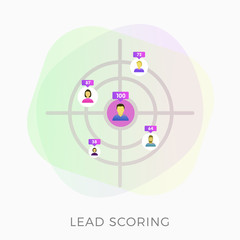The truth is that today’s online business landscape is more competitive than ever before. Multitudes of businesses all compete to generate quality leads. Therefore, to grow your business, you need to earn your audience’s attention.
For a successful lead capture strategy, earning quality leads is paramount. A quality lead is a prospect with a high probability of converting into a paying customer. Each business will have a different idea of what a quality lead is and should be based on their buyer personas.
If you want to generate better leads through your lead capture pages and lead capture forms, every lead generation effort your business makes will need to work together.
Through content marketing, blogging, social media, live chats, SEO, and paid media, you can attract the right type of people to your website. Everything your business does should be coherent with your buyer personas to pique a user’s interest and lead them onto your site.
Once there, a user can read your content, see the products and services your offer, and gain a greater interest in your brand. This is the ideal time to fully capture a visitor’s attention. By persuading them to share a bit of their information, your business may be able to reconnect with them in the future – a process known as lead capture.
Lead capture
Lead capture is the third and final step of the lead generation process. It is a strategy that aims to get a landing page visitor to provide their name, email address, and other information in exchange for valuable information such as a subscription to email newsletters or an eBook.
A lead capture page, also known as a landing page, and its lead capture form, are built to convert your website’s traffic into leads. It does this by presenting a single offer, something of value to the visitor in exchange for their information. At its core, the lead capture page is a way for businesses to ask their visitors for permission to contact them later.
For this to work, you will need to create interesting and valuable content that can generate leads. Your content should speak to your target audience, that is, your buyer persona. By publishing great content and using strategies to improve your SEO, social media presence, and ad click-through rates, your content is likely to have greater outreach online.
Once you have this down, you’ll make it easier for the right kind of people to access your content, learn from it, and be willing to share tidbits of their information with your brand. With the use of lead magnets, killer landing page conversion tactics, and a lead scoring strategy, any business can be successful at capturing prospect’s information.
The Challenge of Lead Capture
There are several ways a visitor can land on your website – whether it is by clicking on a search engine result, a social media post sharing some of your content, or an online ad.
While you want more people on your site, what you are likely aiming for is that every visitor purchases a product or service. This is easier said than done, on average 96% of people who visit a business website are not ready to buy yet.
On top of that, most people are not likely to return to a website unless they have a reason to do so. The best way is to give them an incentive to come back, often by creating a relationship that will help businesses communicate with them in the future. This is only possible by capturing bits of their information through a lead capture page.

A working email address and a first name are the primary things you will want to ask from them, making it possible to personalize your future communication. However, visitors will not always want to give a business this type of information to avoid receiving spammy messages.
The key to making lead capture work is to make users feel comfortable giving your business the information it asks for. To make this happen, organizations need to give before they receive. The best thing to give is free information that can prove valuable to your prospects in the form of lead magnets.
Lead Magnets
A lead magnet is a piece of content meant to give value to prospects in exchange for their contact information. Only after offering certain data about themselves such as work email address, first name, and company name, will a visitor have access to a lead magnet.
Lead magnets should always be free. Once a visitor sends their information on a landing page form, can a business legally follow up.
Examples of lead magnets include:
- Case studies,
- eBooks,
- Webinars,
- Guides,
- Detailed infographics,
- Training video series,
- Free trial or a free demo, and
- Bonus tips about a topic.
The lead magnet your business offers on any landing page should reflect the type of content and information your buyer persona(s) will have an interest in. Lead magnets should always educate audiences on your business or your industry. For B2B companies, they should provide leads with extra information they can use to benefit their own business.
Landing Page Conversion Strategies
A landing page is any web page a user lands on after clicking on an online ad or a social media post. Landing pages are separate from a website’s homepage. They are the most important element in lead capture because they provide a place for brands to offer their lead magnet and capture a visitor’s information. 68% of B2B companies use landing pages to nurture new sales leads for future conversion.
There are two types of landing pages:
- Lead generation
- Click-through landing page.
Lead generation landing pages are often used in lead capture because their end goal is to attain users’ information in exchange for a lead magnet. A click-through landing page is used to educate site visitors on a specific product or service the site wants them to buy.
A landing page is successful when it can persuade quality leads to hand over some of their information.
The average conversion rate for landing pages is 2.35%. While this figure can fluctuate based on your target audience, your industry, and the product or service a landing page is targeting, every business can improve their landing page conversion rates by optimizing many of the same things.
One way to do this is by targeting a singular marketing goal per landing page. This can range from getting 100 leads within a demographic area to give their information or A/B testing different lead magnets to see which one receives more downloads.
The idea is to cut any non-essential information from your landing pages. This also includes using a concise call-to-action, offering only 1 lead magnet, and strategically choosing how much information to ask.
It also implies keeping a consistent message throughout. If you are running a PPC ad whose headline reads “Free 3-part video series on generating more sales”, you will need to continue with this message on the landing page. You will also need to deliver on your promise and offer the video series your ad mentions.
By staying consistent, users can view your landing page as reliable and be more inclined to share information with you.
Making sure your landing page copy and design are similar are also important conversion factors to consider.
Lead Scoring
Lead scoring is a method of assigning “points” to every lead your landing pages generate. It is used to help businesses determine which leads are ready to buy, which are likely to convert into customers over time, prioritize lead nurturing tactics, and adjust how businesses interact with their leads.
Lead scoring is an important component of a successful lead capture strategy because it allows businesses to assess how effective their SEO, ad campaigns, and lead generation efforts are at attracting quality leads. It is also useful in helping organizations save time and money by identifying the prospects who are very interested in their business.
Despite these benefits, most organizations aren’t using lead scoring, 79% of B2B marketers report their business does not use this approach.

Each prospect is assigned a lead score that reflects how similar he or she is to the business’s buyer persona. Leads are often scored on a 0-100-point range, 0 meaning a prospect is vastly different from a buyer persona and 100, meaning they are remarkably similar.
Factors such as demographics, company information, previous engagement with the brand, and how they interact with your business website, all contribute to a lead’s overall score.
lead scoring in practice
Let’s say you are a B2B marketer for a software company called Payroll Max. Payroll Max is popular for its monthly and annual subscriptions of accounting software. Your business has a total of three different buyer personas, but today you want to score a lead based on the criteria for one of these.
This buyer persona is for middle-aged business owners who have more than 10 employees and are looking for affordable accounting software that takes care of employee payroll and taxes. Your organization also wants prospects to have previously interacted with your website.
Using this information, you will assign points to leads based on how similar they are with your chosen persona.
Let's assign some point values for a lead based on this criterion:
- Part of an organization with more than 10 employees – add 10 points
- Based in the United States – add 10 points
- Based outside of the United States – deduct 5 points
- Filled out a lead capture form – add 15 points
- The job role is not a match to the buyer persona – deduct 8 points
- Unsubscribed from the email list – deduct 12 points
- Downloaded a lead magnet – add 6 points
In this example, you have a lead who is a small business owner with 20 employees. They are based in Philadelphia and previously filled out a lead capture form for a free demo and downloaded a lead magnet. Based on your point value system, this lead would be assigned 41 points.
Other leads scored 20, 55, and 10 points. Using the lead scoring approach, the Payroll Max marketing team will be better equipped to nurture leads who are more likely to purchase a software subscription.
Essentially, the number of points each element is assigned will depend on how important it is to your business’s overall marketing strategy. In contrast, if the product(s) or service(s) you offer are catered to a specific industry or demographic area, then any leads that don’t fall within this criterion will likely have a lower lead score.
Conclusion
A successful lead capture strategy requires the correct use of lead magnets, landing page conversion tactics, and a lead scoring system that can help businesses target quality leads. These leads will have a greater interest in making a purchase.
When you use the information you’ve collected on your buyer personas and create compelling content and lead magnets that speak to this audience, you’re more likely to capture their information.




